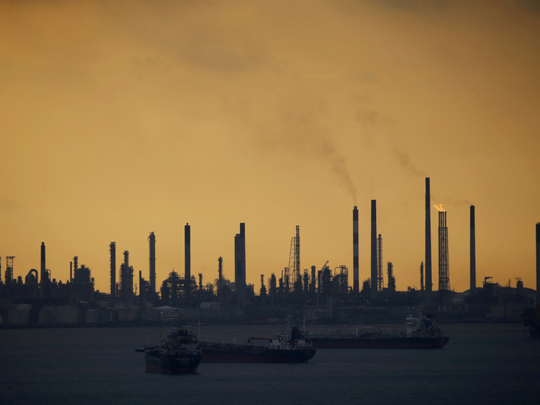
SINGAPORE: Oil futures pushed closer to $50 a barrel on Wednesday, with US crude hitting its highest in over seven months after industry data suggested a larger-than-expected drawdown in US crude inventories last week.
Oil markets were also supported by an overnight surge in US equities and strong home sales that could point to the Federal Reserve raising interest rates as early as June.
US crude futures had climbed 71 cents to $49.33 a barrel by 0652 GMT, after ending the previous session up 54 cents. The benchmark earlier on Wednesday touched its highest since mid-October at $49.45.
Brent futures rose 65 cents to $49.26 a barrel, having ended the last session up 26 cents to snap a four-day slide.
US crude, or West Texas Intermediate (WTI), remained at a premium to Brent after flipping above the international benchmark before the last close.
US crude stocks dropped by 5.1 million barrels to 536.8 million last week, data from industry group the American Petroleum Institute showed. That was double expectations of analysts polled by Reuters.
Some of the drawdown was caused by falling imports due to wildfires in Canada, which lost about 1.5 million barrels per day in production, said Ben Le Brun, market analyst at Sydney online brokerage OptionsXpress. Although some crude producers restarted operations on Tuesday in Canada’s energy heartland.
“A strong US economy is (also) good for oil consumption and demand,” Le Brun said.
Investors are awaiting confirmation of the big draw when the US Energy Information Administration (EIA) issues official inventory figures on Wednesday.
“Technically, the market is gearing up for WTI to go above $50 a barrel and it is intriguing on where it goes from there,” Le Brun added.
“I think the cap is not too far above that level - the world is still awash with oil even if it is off the peaks.” His views were echoed by Masanobu Hamada, general manager of the crude oil trading department at JX Nippon Oil & Energy Corp, who said the current price rise was due to supply disruptions.
“Unless there is a halt in supply, the market lacks material (strength) to go higher because the inventory levels are high,” Hamada said.
Oil prices were buoyed by a rise in US stocks, but appeared to shrug off the impact from a stronger US dollar.
Meanwhile, Iraq is pumping about 4.5 million bpd now and is aiming to boost that to up to 6 million bpd by 2020, said the head of Iraq’s State Oil Marketing Organisation (SOMO).












